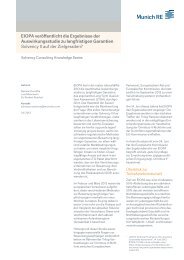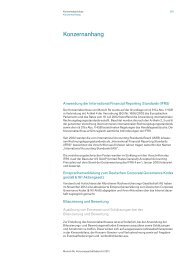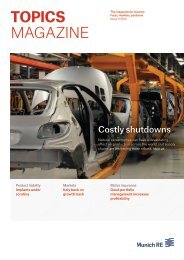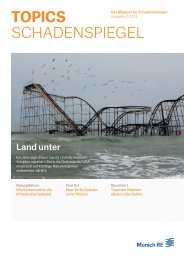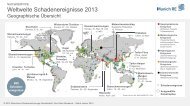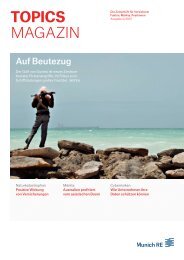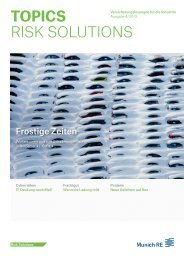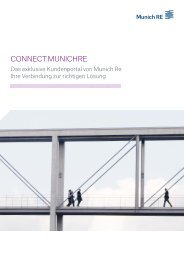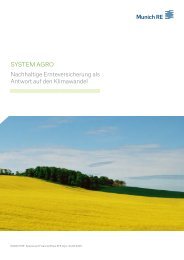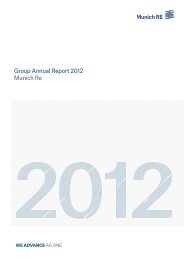Munich Re Group Annual Report 2006 (PDF, 1.8
Munich Re Group Annual Report 2006 (PDF, 1.8
Munich Re Group Annual Report 2006 (PDF, 1.8
You also want an ePaper? Increase the reach of your titles
YUMPU automatically turns print PDFs into web optimized ePapers that Google loves.
<strong>Munich</strong> <strong>Re</strong> <strong>Group</strong> <strong>Annual</strong> <strong>Re</strong>port <strong>2006</strong> General information_Glossary<br />
C – D<br />
Cash-generating unit<br />
The smallest identifiable group of assets that generates cash inflows<br />
largely independent of the cash inflows from other assets or groups<br />
of assets. If the recoverable amount of an asset cannot be determined<br />
individually in the impairment test for assets under IAS 36, the<br />
recoverable amount of a cash-generating unit to which the relevant<br />
asset belongs must be determined.<br />
Catastrophe bond<br />
Also referred to as “cat bonds” and “act of God bonds”, catastrophe<br />
bonds are used to transfer natural catastrophe risks to the capital<br />
markets. The buyers of such bonds profit from a comparatively high<br />
coupon rate, but assume all or part of the (re)insurer’s risk with<br />
regard to a natural catastrophe. If a catastrophe exceeds the predefined<br />
parametric trigger, some or all of the capital and interest is<br />
used to pay the (re)insurer’s financial loss from the natural catastrophe<br />
instead of being repaid/credited to the buyers.<br />
Cedant<br />
Client of a reinsurance company (see also primary insurers).<br />
Chain ladder method<br />
Standard (multiplicative) actuarial method used to estimate the<br />
reserves needed for future claims expenditure on the assumption<br />
that the cumulative loss will rise by the same factor in all accident<br />
years. With this method, the overall loss expected is determined<br />
exclusively on the basis of historical data on the run-off of losses in<br />
the insurer’s portfolio.<br />
Claims equalisation provision<br />
Provisions required by national regulations to smooth fluctuations in<br />
loss experience in future years. In IFRS accounting, they are recognised<br />
in equity.<br />
Combined ratio<br />
Percentage ratio of the sum of net claims expenses plus net operating<br />
expenses to net earned premiums. It corresponds to the sum of<br />
the loss ratio and the expense ratio.<br />
Compliance guidelines<br />
Rules for handling inside information. As a general principle, inside<br />
information may not be used for a person’s own investment transactions,<br />
for transactions conducted by a bank or for recommendations<br />
to others. Therefore, as part of the compliance procedure, business<br />
transactions are checked to make sure they are not based on inside<br />
information.<br />
Composite insurer<br />
Insurer that writes both life and non-life business.<br />
220<br />
Consolidation<br />
Combining the items from the individual financial statements of the<br />
companies belonging to the <strong>Group</strong> into one consolidated financial<br />
statement, in which items involving intra-<strong>Group</strong> transactions are<br />
eliminated.<br />
Contingent liabilities<br />
Possible obligations whose existence will be confirmed by the occurrence<br />
or non-occurrence of an uncertain future event and which are<br />
therefore not shown as liabilities in the balance sheet. They must,<br />
however, be included in the notes to the financial statements (e.g.<br />
guarantee obligations).<br />
Corporate governance<br />
The legal and factual framework for managing and monitoring companies.<br />
Corporate governance rules serve to provide transparency<br />
and thus strengthen confidence in responsible management and<br />
control geared to the creation of value.<br />
Customised Portfolio Solutions (CPS)<br />
CPS is <strong>Munich</strong> <strong>Re</strong>’s centre of competence for retrospective reinsurance<br />
cover in non-life classes of business. Frequently also referred to<br />
as run-off cover, this protects the cedant against the risk of loss portfolios<br />
producing worse run-off results than expected.<br />
Debt leverage<br />
The percentage ratio of strategic debt to the sum of <strong>Group</strong> equity and<br />
strategic debt.<br />
Deferred acquisition costs<br />
Costs incurred for the acquisition or the renewal of insurance policies<br />
(e.g. commission, cost of processing applications) which are<br />
capitalised and amortised over the term of the contracts.<br />
Deferred tax assets/liabilities<br />
Deferred taxes derive from temporary differences between accounting<br />
on the basis of IASs/IFRSs and national tax law. If in the consolidated<br />
financial statements asset items are valued lower, or liabilities<br />
higher, than in the tax accounts of the <strong>Group</strong> company concerned,<br />
the resulting future tax relief must be recognised as a deferred tax<br />
asset. Also included are tax assets deriving from tax loss carry-forwards.<br />
If the accounting differences between the consolidated financial<br />
statements and tax accounts will lead to future tax burdens,<br />
these must be recognised as deferred tax liabilities. Deferred tax<br />
assets are reversed if a realisation of the receivable is not probable.<br />
Delcredere<br />
Delcredere insurance provides suppliers of goods or services with<br />
insurance against the risk of default due to insolvency of the customer.



